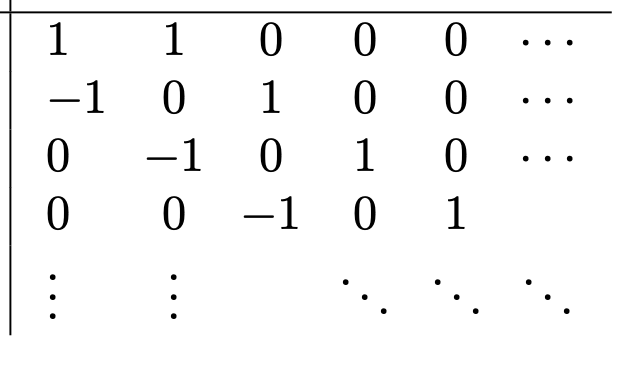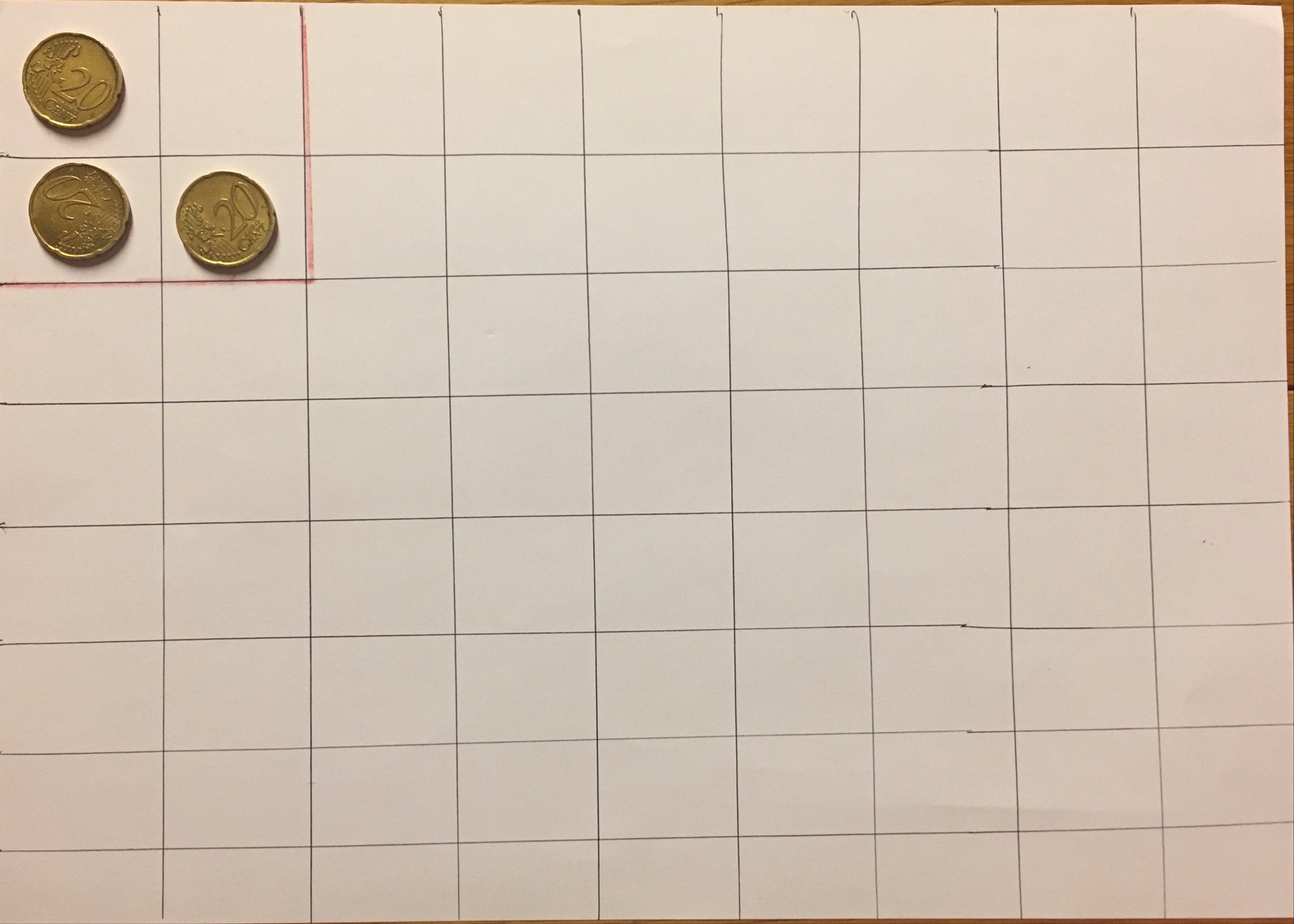A while back I set a puzzle asking you to try to remove three coins from a red square region as shown in the following diagram.

The only rule of the game is that when a coin is removed it is replaced with 2 coins – 1 immediately to the right of and one immediately below the coin that is removed. If there is no space for adding these replacement coins, the coin cannot be removed.
The puzzle actually appeared in a recent edition of Alex Bellos’ Guardian mathematics puzzles, though it was created by the Argentinian mathematician Carlos Sarraute. This is his solution which is astonishing for its breathtaking ingenuity.
The solution starts by giving a value to every square in the grid as follows:

Remember, the grid goes on forever both to the right and downwards. The top left hand box has value 1. Going right from there, every subsequent square has value equal to 1/2 of the previous one. So: 1, 1/2, 1/4, 1/8 and so on. The first column is identical to the first row. To complete the second row, we start with the first value, 1/2, and again just keep multiplying by 1/2. The second column is the same as the second row. And we fill the entire grid this same way. Technically, every row and column is a series of geometric numbers: consecutive multiples of a common number, which in this case is 1/2.
Let’s define the value of a coin to be the value of the square its on. Then the total value of the coins at the start of the game is
1 + \frac{1}{2} + \frac{1}{2}= 2
Now…
-
- When we remove a coin we replace it with two coins, one immediately to the left and one immediately to the right. But if you look at the value any square on the grid, it is equal to the sum of the values of the squares immediately below and to the right. So when we remove a coin we replace it with two coins whose total value is the same. It follows that the total value of the coins stays unchanged however many moves we make. It will always be 2 however many moves we make.
- This is the only tricky mathematical part. Look at the first row of numbers. It consists of 1, 1/2, 1/4, 1/8… and goes on forever. But even though this is an infinite sequence it has a finite sum of 2. Obviously, we can never really add infinitely many numbers in practice, but by adding more and more terms in the series we will get closer and closer to the value of 2. Try it on a calculator. In summary:
- Working down the rows, the second row is the same as the first with the first term removed. So its sum must be 1. The third is the same as the second with the first term of 1/2 removed, so its sum is 1/2. By the same reasoning, the sum of the fourth row will be 1/4, the fifth row 1/8 and so on.
- So, the row sums are respectively 2, 1, 1/2, 1/4, …. This is the same as the values of the first row with the additional first term of 2. It follows that the sum of the row sums, and therefore the sum of all numbers in the grid is 2+2=4. Again, we can’t add all the numbers in the practice, but we will get closer and closer to the value of 4 by adding more and more squares.
- The total value of the squares inside the red square is 1 + 1/2 + 1/2 + 1/4 = 9/4. The total value outside this region must therefore be 2-9/4= 7/4.
- Putting all this together, the initial value of the coins was 2. After any number of moves, the total value of all coins will always remain 2. But the total value of all squares outside the red square is only 7/4. It must therefore be impossible to remove the three coins from the red square because to do so would require the coins outside of this area to have a value of 2, which is greater than the total value available in the entire region.
I find this argument quite brilliant. My instincts were to try to solve the puzzle using arguments from geometry. I failed. It would never have occurred to me to try to develop a solution based on the properties of numbers.
As I wrote in the original post, this puzzle doesn’t really have any direct relevant to Statistics except in so much as it shows the power and beauty of mathematical proof, which is an essential part of statistical theory. Having said that, the idea of infinite limits is important in Statistics, and I’ll discuss this in a further post. Let me just mention though that summing infinite series as in the solution above is a delicate issue for at least two reasons:
- Although the sum 1 + 1/2 + 1/4 + 1/8 + …. has a finite sum of 2, this series 1 + 1/2 + 1/3 + 1/4 + 1/5 + …. has no finite sum. The sum grows very slowly, but as I take more and more numbers in the series, the sum grows without any limit. That’s to say, if you give me any number – say 1 million – I can always find enough terms in the series for the sum to be greater than that number.
- To get the total value of the grid, we first added the rows and then added these row sums across the columns. We could alternatively have first added the columns, and then added these columns sums across the rows and we’d have got the same answer. For this example both these alternatives are valid. But in general this interchange of row and column sums to get the total sum is not valid. Consider, for example, this infinite grid:
 The first row sums to 2, after which all other rows sum to zero. So, the sum of the row sums is 2. But looking at the columns, even column sums to zero. So, if we sum the columns and then sum these sums we get 0. This couldn’t possibly happen with finite grids, but infinite grids require a lot more care.
The first row sums to 2, after which all other rows sum to zero. So, the sum of the row sums is 2. But looking at the columns, even column sums to zero. So, if we sum the columns and then sum these sums we get 0. This couldn’t possibly happen with finite grids, but infinite grids require a lot more care.
In a follow-up post we’ll consider limits of sums in the context of Statistics.
Finally, I’m grateful to Fabian for some follow-up discussion on the original post. In particular, we ended up discussing the following variation on the original puzzles. The rules are exactly the same as before, but the starting configuration of the coins is now as per the following diagram:

In this case, can the puzzle be solved? Does the argument presented for the original problem help in any way?
If you have any thoughts about this, please do write to me. In any case, I’ll write another post with the solution to this version shortly.
